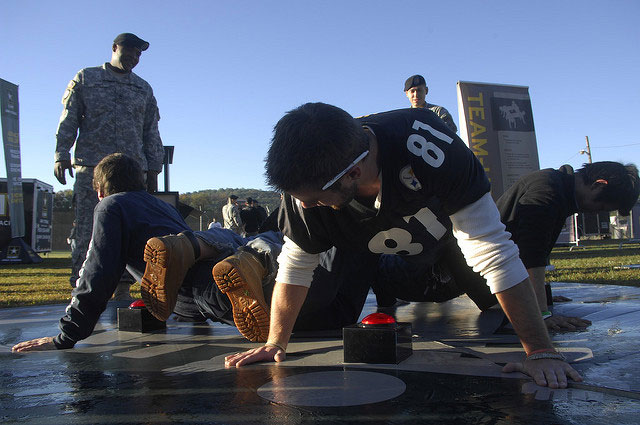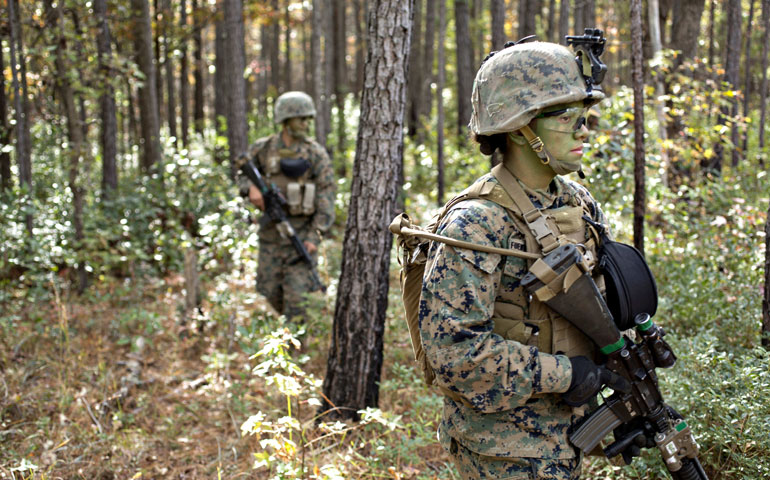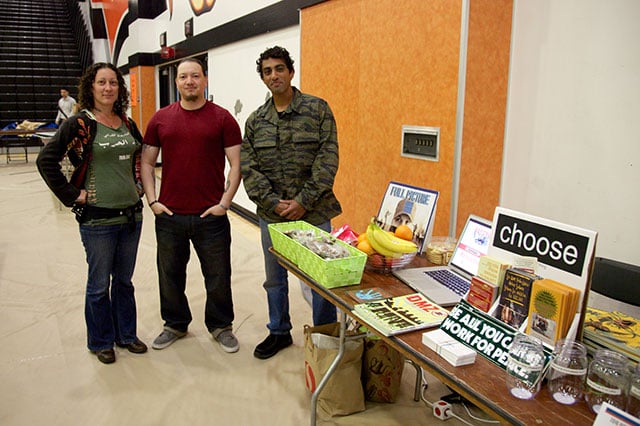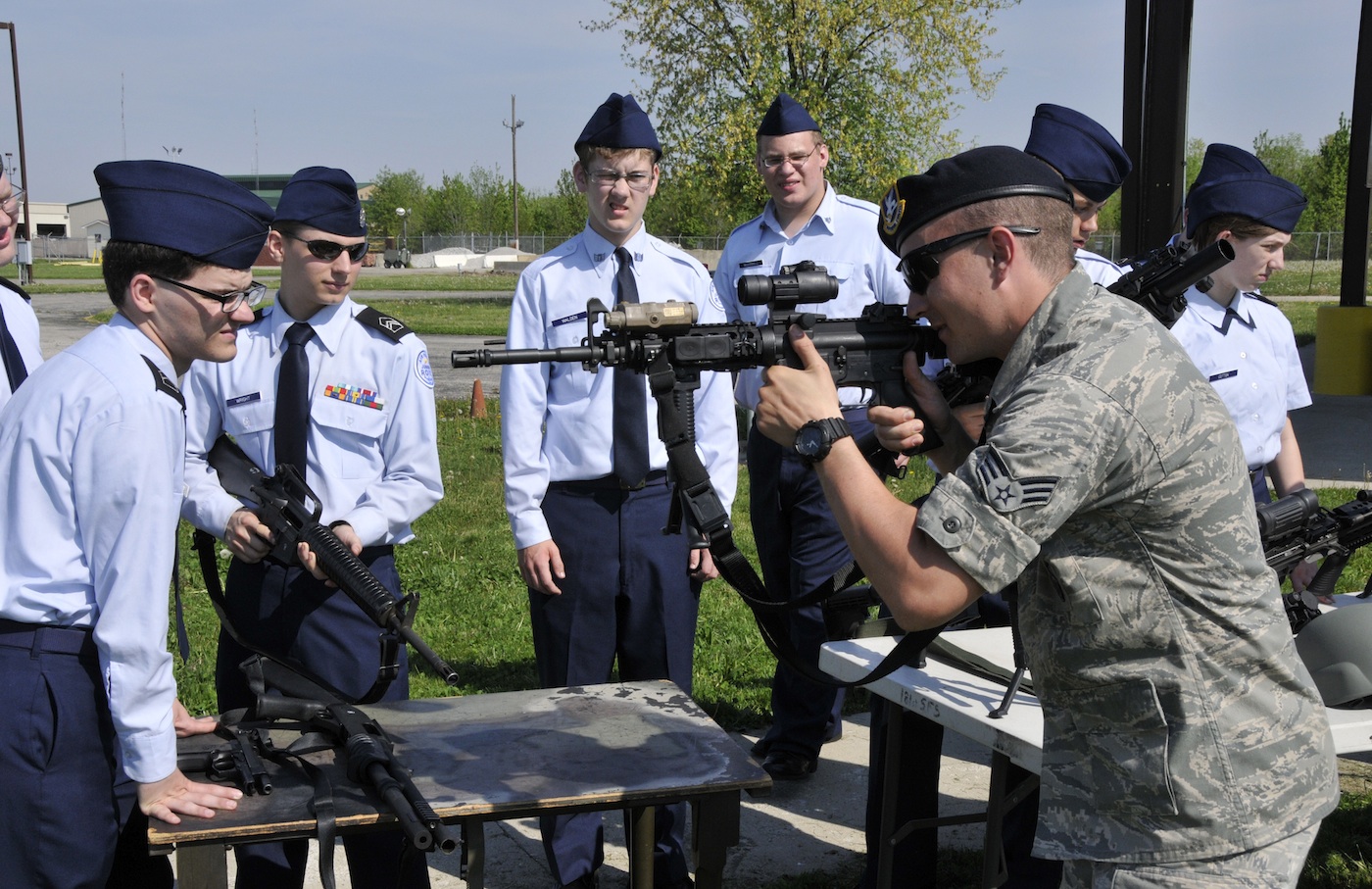'No Child Left Behind' is formally named the ESEA (Elementary and Secondary Education Act.) The 2002 version of ESEA, also known as 'No Child Left Behind' or 'NCLB', has turned our schools into testing factories where knowledge and wisdom are given second place to the selling strategies of big textbook manufacturers and testing companies. This is part of an overall privatization of public education that many teachers unions, such as UTLA (United Teachers Los Angeles), are trying to stop. Many teachers have left the teaching profession in frustration at the incoherent demands of 'NCLB' and the lack of funding from the federal government that 'NCLB' requires. The 'NCLB' act also opens the schools doors to military recruiters, giving them access to all public secondary schools (high schools) and funnels students names, home phone numbers, and home addresses into the Pentagon (see the actual legal language of Section 9528 of ESEA 'NCLB' below.) ASVAB testing and the Pentagon Database student information mining project are other ways military recruiters can get this information. For more information about ASVAB and the Pentagon Database go to our JROTC page.
A CAMS AFT/CFT member (yours truly) wrote this Resolution on eliminating Section 9528 from any reauthorization of NCLB at the California Federation of Teachers Convention 2007 in Los Angeles, CA. It was passed unanimously.
Arlene Inouye passed this New Business Item for the NEA (National Education Association): NEA Representative Assembly
New Business Item 49
Rationale/Background:
The military recruitment of minors in our schools deeply impacts upon their future and quality of life for many of our students. ESEA section 9528 presently states that the release of secondary student directory information ( name, address and phone number) will be released to military recruiters upon request unless an "Opt Out" form is signed and returned. Representative Mike Honda has introduced HR 1346 to amend Section 9528 because of student and parent privacy concerns. This amendment would replace the "Opt Out" provision of the NCLB with an "Opt In" policy that requires parent or student consent before releasing privacy information to military recruiters.
Test of the Motion:
Using exiting communication vehicles (including NEA Today, and publications), the NEA will publish an update on the issue of military recruitment in schools. This will include section 9528 of the ESEA and HR 1346 to amend it.
Submitted by: 50 Delegates
Contact: Arlene Inouye, California
Relevant Operational Service (OS) Area: OS-3 Communications
Cost Implications: This NBI can be accomplished within the proposed 2007-8 Strategic Plan and Budget at no additional cost.
CAMS has also put together this one sheet on NCLB and what concerned educators, parents, and activists can do in a PDF format. There is a sample letter to Congress at the bottom of this page.
Here is a good link for 'NCLB':
Public Education Network: No Child Left Behind
A new bill, H.R. 1346 by Representative Michael Honda, would remove Section 9528 for NCLB and needs support.
What you can do:
Call or write, or better yet, visit your Congressperson and ask them to support the Student Privacy Protection Act of 2005 (H.R. 551), a bill introduced in the House of Representatives in 2005 but held up and ignored by previous Congresses which reverses Section 9528 of ESEA and requires schools to first obtain parental permission before releasing private student information to military recruiters (opt-in). The bill has been referred to the House Education and the Workforce and the House Education and the Workforce, Subcommittee on Education Reform.
Washington DC House switchboard: 202-225-3121
Washington DC Senate switchboard: 202-224-3121
When you talk to your Congressperson or Senator remind them that:
~ ESEA "NCLB" is up for reauthorization in 2007.
~ Section 9528 of ESEA "NCLB" jeopardizes student privacy and was put into the ESEA without any input from parents.
~ Many times even when a parent 'opts-out' as defined in Section 9528 (a) (2) Consent the child is still contacted by military recruiters.
~ Ask your Congressperson to insist that any reauthorization of "NCLB" be contingent on the removal of Section 9528 or a rewording of it emphasizing the privacy rights of students and parents from military recruiters.
Sample letter requesting a meeting with a congressperson:
<><><><><><><><><><>
To: The Honorable xxxxxxxxx
From: xxxxxxxxx
Via Fax: 202-226-xxxx
Date: February 9, 20xx
Dear Congressperson xxxxx:
I would like to request a meeting with you, personally, concerning the upcoming reauthorization vote of ESEA (‘No Child Left Behind’.) As at teacher in PI5 Title One school I am very concerned about a number of components within NCLB, in particular the AYP standard as regards EL (English Learner) populations, educationally bland ‘teaching-to the test’ mandated curriculum, and Section 9528 of NCLB, which evaporates privacy protections for students to military recruiters and allows military recruiters to patrol High School campuses. As with any mandated Federal program, NCLB’s funding issues are also in need of scrutiny and discussion. And, finally, the privatization measures inherent within NCLB’s penalization of schools not meeting AYP needs to be analyzed and remedied.
While I am not sure we can discuss all of these issues, or even realize agreements on any, I do feel I need to meet with my representatives to tell them of the inadequacies, the incoherence, and the damage being done to students by certain components within the existing legislation.
As a working teacher I can meet with you any weekday after 4:30 pm, or on a Saturday at your Los Angeles office. I have met in the past with your local staff but would like to meet with you attending this time.
I look forward to meeting with you at your earliest convenience.
Sincerely,
No Child Left Behind Act Regarding Military Recruitment
December 2002
115 STAT. 1425 PUBLIC LAW 107–110—JAN. 8, 2002
Public Law 107–110
107th Congress
An Act To close the achievement gap with accountability, flexibility, and choice, so that no child is left behind.
Be it enacted by the Senate and House of Representatives of the United States of America in Congress assembled, Jan. 8, 2002 [H.R. 1]
‘‘SEC. 9528. ARMED FORCES RECRUITER ACCESS TO STUDENTS AND STUDENT RECRUITING INFORMATION.
‘‘(a) POLICY.—
‘‘(1) ACCESS TO STUDENT RECRUITING INFORMATION.—Notwithstanding section 444(a)(5)(B) of the General Education Provisions Act and except as provided in paragraph (2), each local educational agency receiving assistance under this Act shall provide, on a request made by military recruiters or an institution of higher education, access to secondary school students names, addresses, and telephone listings.
‘‘(2) CONSENT.—A secondary school student or the parent of the student may request that the student’s name, address, and telephone listing described in paragraph (1) not be released without prior written parental consent, and the local educational agency or private school shall notify parents of the option to make a request and shall comply with any request.
‘‘(3) SAME ACCESS TO STUDENTS.—Each local educational agency receiving assistance under this Act shall provide military recruiters the same access to secondary school students as is provided generally to post secondary educational institutions or to prospective employers of those students.
‘‘(b) NOTIFICATION.—The Secretary, in consultation with the Secretary of Defense, shall, not later than 120 days after the date of enactment of the No Child Left Behind Act of 2001, notify principals, school administrators, and other educators about the requirements of this section.
‘‘(c) EXCEPTION.—The requirements of this section do not apply to a private secondary school that maintains a religious objection to service in the Armed Forces if the objection is verifiable through the corporate or other organizational documents or materials of that school.
‘‘(d) SPECIAL RULE.—A local educational agency prohibited by Connecticut State law (either explicitly by statute or through statutory interpretation by the State Supreme Court or State Attorney General) from providing military recruiters with information or access as required by this section shall have until May 31, 2002, to comply with that requirement.
Source: https://web.archive.org/web/20121017081654id_/http://www.militaryfreeschools.org/nochild.html
###

 "Back when we started, recruiters were just blatantly lying to the kids," said Susan Quinlan, the co-founder and volunteer coordinator of the peace and justice group,
"Back when we started, recruiters were just blatantly lying to the kids," said Susan Quinlan, the co-founder and volunteer coordinator of the peace and justice group, 



 On a Wednesday afternoon last month, a group of gray-haired women with canes and Styrofoam guns lined the streets outside the New York City Department of Education’s headquarters in Brooklyn. “Get the military out of our schools!” they shouted, capturing pedestrians’ attention. “No more JROTC!” These were the courageous women of the Granny Peace Brigade, and they were there to protest what they see as the militarization of the city’s public schools.
On a Wednesday afternoon last month, a group of gray-haired women with canes and Styrofoam guns lined the streets outside the New York City Department of Education’s headquarters in Brooklyn. “Get the military out of our schools!” they shouted, capturing pedestrians’ attention. “No more JROTC!” These were the courageous women of the Granny Peace Brigade, and they were there to protest what they see as the militarization of the city’s public schools. Though the
Though the  David Swanson is the author of the new book, Daybreak: Undoing the Imperial Presidency and Forming a More Perfect Union, by Seven Stories Press and of the introduction to The 35 Articles of Impeachment and the Case for Prosecuting George W. Bush by Dennis Kucinich. In addition to cofounding AfterDowningStreet.org, he is the Washington director of Democrats.com and sits on the boards of a number of progressive organizations in Washington, DC.
David Swanson is the author of the new book, Daybreak: Undoing the Imperial Presidency and Forming a More Perfect Union, by Seven Stories Press and of the introduction to The 35 Articles of Impeachment and the Case for Prosecuting George W. Bush by Dennis Kucinich. In addition to cofounding AfterDowningStreet.org, he is the Washington director of Democrats.com and sits on the boards of a number of progressive organizations in Washington, DC. Jorge Mariscal is the grandson of Mexican immigrants and the son of a U.S. Marine who fought in World War II. He served in the U.S. Army in Vietnam and currently teaches at the University of California, San Diego.
Jorge Mariscal is the grandson of Mexican immigrants and the son of a U.S. Marine who fought in World War II. He served in the U.S. Army in Vietnam and currently teaches at the University of California, San Diego. Matt Guynn plays the dual role of program director and coordinator for congregational organizing for On Earth Peace, building peace and nonviolence leadership within the 1000+ congregations of the Church of the Brethren across the United States and Puerto Rico. He previously served a co-coordinator of training for Christian Peacemaker Teams, serving as an unarmed accompanier with political refugees in Chiapas, Mexico, and offering or supporting trainings in the US and Mexico.
Matt Guynn plays the dual role of program director and coordinator for congregational organizing for On Earth Peace, building peace and nonviolence leadership within the 1000+ congregations of the Church of the Brethren across the United States and Puerto Rico. He previously served a co-coordinator of training for Christian Peacemaker Teams, serving as an unarmed accompanier with political refugees in Chiapas, Mexico, and offering or supporting trainings in the US and Mexico. Rick Jahnkow works for two San Diego-based anti-militarist organizations, the Project on Youth and Non-Military Opportunities and the Committee Opposed to Militarism and the Draft. He can be reached at:
Rick Jahnkow works for two San Diego-based anti-militarist organizations, the Project on Youth and Non-Military Opportunities and the Committee Opposed to Militarism and the Draft. He can be reached at:  Pat Elder was a co-founder of the
Pat Elder was a co-founder of the 